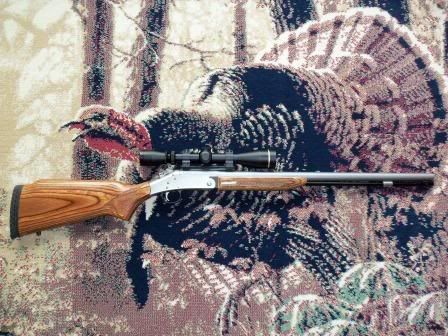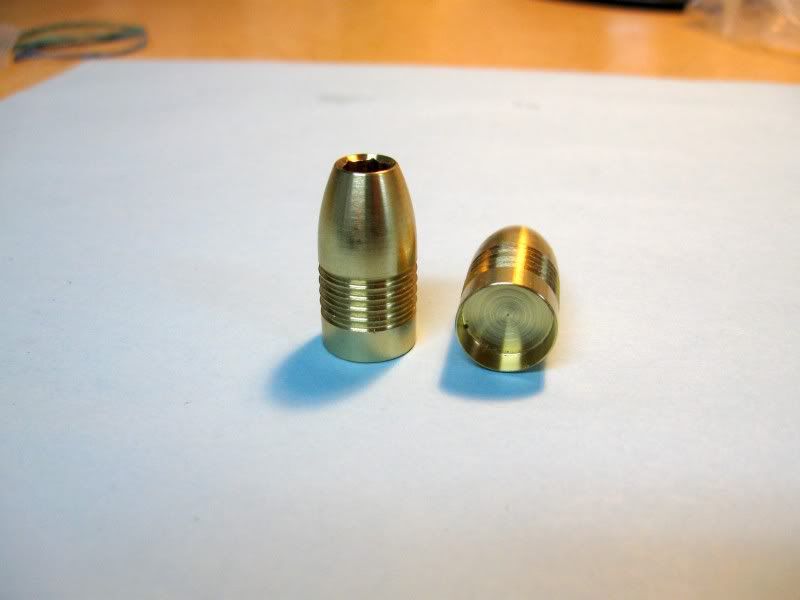- Joined
- May 19, 2005
- Messages
- 9,205
- Reaction score
- 1,740
This seems like a very popular topic of late. And since I also know that Knight wants to come back with one in 2012.. I have some interest in the subject
I currently have a couple of Elite 1-30 twist rifles and they serve my needs very well. Since I am shooting basically two bullet from these rifles, a Lehigh 40-200 and a Speer .40-180 grain bullet - it does serve my purpose.
The shorter Speer bullet being shot at 22-2300 fps works perfectly into the 1-30 twist - very accurate and very good ballastics. But, the Lehigh is on the long end of the twist as I also imagine is the Barnes 195.
The Lehigh/Bloodline at 22-2300 fps works very well from the twist but for a lot of other is marginal, hence the Lehigh 40-185 which fits into the 1-30 twist, as well as most of the other twist rates available. Even the 40-200 will fit into the 1-28 and under rate and be very accurate.
So now that people are asking for the higher twist - I wondered why the 1-20 was such a failure in the period of time they (different manufactures) tried it.
One thing I would add to to this is that most 40 cal bullets that we shoot were never designed to be shot in a rifle so the velocity that these bullets reach from a muzzle of a pistol is probably very different than what most are trying to push from a ML.
This problem leads to another problem - construction of the bullet... which I think may have created the problem in a 1-20, even more than the ability of the sabot to handle the spin.
The term 'Over Stabilization' is often used as a problem but in theory 'over stabilzation' does not occur but because of rate of spin bullet problems as accentuated... sort of like shooting a PRB with a hot load from a fast twist barrel. I have highlited this discsussion in the article.
I found this basic explanation on the net... This explanation also explains the 'Greenhill' formula that Lee often uses.
http://www.loadammo.com/Topics/July01.htm
But as always.. this is just my thinking...
I currently have a couple of Elite 1-30 twist rifles and they serve my needs very well. Since I am shooting basically two bullet from these rifles, a Lehigh 40-200 and a Speer .40-180 grain bullet - it does serve my purpose.
The shorter Speer bullet being shot at 22-2300 fps works perfectly into the 1-30 twist - very accurate and very good ballastics. But, the Lehigh is on the long end of the twist as I also imagine is the Barnes 195.
The Lehigh/Bloodline at 22-2300 fps works very well from the twist but for a lot of other is marginal, hence the Lehigh 40-185 which fits into the 1-30 twist, as well as most of the other twist rates available. Even the 40-200 will fit into the 1-28 and under rate and be very accurate.
So now that people are asking for the higher twist - I wondered why the 1-20 was such a failure in the period of time they (different manufactures) tried it.
One thing I would add to to this is that most 40 cal bullets that we shoot were never designed to be shot in a rifle so the velocity that these bullets reach from a muzzle of a pistol is probably very different than what most are trying to push from a ML.
This problem leads to another problem - construction of the bullet... which I think may have created the problem in a 1-20, even more than the ability of the sabot to handle the spin.
The term 'Over Stabilization' is often used as a problem but in theory 'over stabilzation' does not occur but because of rate of spin bullet problems as accentuated... sort of like shooting a PRB with a hot load from a fast twist barrel. I have highlited this discsussion in the article.
I found this basic explanation on the net... This explanation also explains the 'Greenhill' formula that Lee often uses.
http://www.loadammo.com/Topics/July01.htm
Topic of the Month: July 2001
Twist Rate
Bullet stability depends primarily on gyroscopic forces, the spin around the longitudinal axis of the bullet imparted by the twist of the rifling. Once the spinning bullet is pointed in the direction the shooter wants, it tends to travel in a straight line until it is influenced by outside forces such as gravity, wind and impact with the target.
Rifling is the spiral or helix grooves inside the barrel of a rifle or handgun. These grooves were invented a long time ago, perhaps as early as the 14th century. However, the smooth bore, using the round ball, was the choice of weapons for warfare even through the American Revolutionary war. The smooth bore musket could be loaded faster than the rifle and didn?t foul, as bad, with the combustion products of black powder.
The rifling grooves helix is expressed in a twist rate or number of complete revolutions the grooves make in one inch of barrel length. A 1in10 or 1:10 would be one complete turn in 10 inches of barrel length.
How important is twist rate? David Tubb, a winner of several NRA High Power Rifle Championships, was using a .243 rifle with a 1 in 8.5 twist barrel. He wasn?t able to get consistent accuracy until he changed to a rifle barrel with a 1 in 8 twist. The ?" twist change made all the difference between winning or losing the match.
A term we often hear is "overstabilization" of the bullet. This doesn?t happen. Either a bullet is stable or it isn?t. Too little twist will not stabilize the bullet, while too much twist, with a couple of exceptions, does little harm. Faster than optimum twists tend to exaggerate errors in bullet concentricity and may cause wobble. The faster twist also causes the bullet to spin at higher rpm, which can cause bullet blowup or disintegration because of the high centrifugal forces generated. For example, the .220 Swift, at 4,000 fps., spins the 50-grain bullet at 240,000 rpm.
One of the first persons to try to develop a formula for calculating the correct rate of twist for firearms, was George Greenhill, a mathematics lecturer at Emanuel College in Cambridge, England. His formula is based on the rule that the twist required in calibers equals 150 divided by the length of the bullet in calibers. This can be simplified to:
Twist = 150 X D2/L
Where:
D = bullet diameter in inches
L= bullet length in inches
150 = a constant
This formula had limitations, but worked well up to and in the vicinity of about 1,800 f.p.s. For higher velocities most ballistic experts suggest substituting 180 for 150 in the formula. The twist formulas used in the Load From a Disk program, featured at this web site, uses a modified Greenhill formula in which the "150" constant is replaced by a series of equations that allow corrections for muzzle velocity from 1,100 to 4,000 fps.
The Greenhill formula is simple and easy to apply and gives a useful approximation to the desired twist. The Greenhill formula was based on a bullet with a specific gravity of 10.9, which is about right for the jacketed lead core bullet. Notice that bullet weight does not directly enter into the equation. For a given caliber, the heavier the bullet the longer the bullet will be. So bullet weight affects bullet length and bullet length is used in the formula.
To measure the twist of a barrel, use a cleaning rod and a tight patch. Start the patch down the barrel and mark the rod at the muzzle. Push in the rod slowly until it has made one revolution, and then make a second mark on the rod at the muzzle. The distance between marks is the twist of your barrel.
To see how this works out, assume you bought a .222 Remington rifle and you measured the twist rate as described above. The twist was 1 in 14. You have two .224 bullets you want to use, the 70-grain Speer SPS and the 50-grain Hornady SX. The Speer bullet measures .812 inches in length and the Hornady measures .520 inches. Using the formula above we calculate the following twist rate:
Speer 70-grain: 1 in 9
Hornady 50-grain: 1 in 14
These calculations show that the 50-grain bullet will be stabilized, but the 70-grain won?t. Sure enough, when you try these bullets out, the 50-grain shoots ? MOA while the 70-grain won?t group on the paper at 50 yards. Twist is important!
Watch our web site for the next topic of interest "What is Recoil and how is it Calculated." Until then, shoot safely and know where you bullets are going.
Sincerely,
The Ballistician
But as always.. this is just my thinking...








